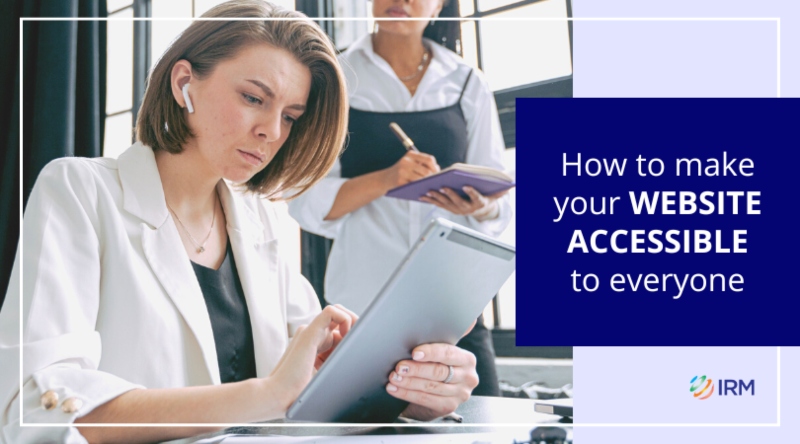
- Website accessibility is central for ensuring that everyone, regardless of their abilities or disabilities, can reach the information on your site.
- It also benefits your business through improving user experience and search engine rankings.
- Some ways to make your site more accessible are utilising alt tags, headings and subheadings, as well as transcripts.
Website accessibility has become increasingly fundamental in the modern digital era. Accessible sites ensure that every person, no matter their abilities or disabilities, can access information and services online. As a website owner, it's your responsibility to make your site available to each user, particularly your investor audience.
Why is website accessibility important?
The World Health Organization estimates that approximately 16% of the world's population has some form of disability. This means that a significant portion of your potential audience may have difficulties accessing your site if it's not designed with accessibility in mind.
Accessibility on your website is relevant from a legal perspective too. In many countries, there are laws and regulations that require sites to be accessible to all. For example, in Australia, organisations are expected to comply with the Disability Discrimination Act 1992 (DDA) and the Web Content Accessibility Guidelines (WCAG) 2.0. These standards assure that sites are reachable to anybody.
Moreover, accessible websites benefit all users, not just those with disabilities. In particular, optimising your site for accessibility can improve its search engine rankings, increase usability, and improve the overall user experience.
 Website accessibility makes sure everyone can reach your site.
Website accessibility makes sure everyone can reach your site.
How to make your website accessible
Is your website accessible to each one in your investor community? Consider some practical ways to make it more easy to tap into:
1. Have alt tags for images
Alt tags provide a text alternative for images and this is especially crucial for people who are visually impaired and rely on screen readers to navigate websites. Without alt tags, screen readers cannot provide a description of the images to users, which can lead to confusion and frustration. That’s why it’s imperative to include alt tags for all images on your site, including icons and logos.
In your alt tags, make sure that the alt text is understandable and provides enough detail to convey the meaning of the image. Avoid generic or vague alt text, such as "image" or "picture." Instead, use specific text that accurately describes the image and its purpose.
2. Apply descriptive headings and subheadings
Headings and subheadings provide structure and organisation to your content, making it easier for users to find the info they need on your website. For people who use screen readers or have cognitive disabilities, clear and coherent headings can make a significant difference in their ability to understand and navigate your site.
For your headings, refrain from generic headings, such as "Introduction" or "Main Content" as they do not provide any meaningful details about the section. Instead, use descriptive headings that accurately convey the topic and purpose of each section. Use proper HTML markup, which helps screen readers and other assistive technologies to understand the hierarchy of the content and navigate the page more efficiently.
3. Provide transcripts for audio and video
Transcripts are text-based versions of your audio or video content that screen readers can read, making the message obtainable to people who are deaf or hard of hearing. Transcripts can also benefit those who prefer to read rather than listen to audio or watch videos. They can also be helpful for people who have cognitive disabilities or difficulty processing facts presented in audio or visual formats.
In your transcripts, provide a complete and accurate representation of your audio or video material. This includes not only the spoken words, but any sound effects, music, or other audio elements that are part of the content too. See to it that the transcripts are quick to find on the website. Consider providing a link to the transcript near the audio or video, or embedding the transcript directly into the webpage.
 Website accessibility taps alt tags, headings and transcripts.
Website accessibility taps alt tags, headings and transcripts.
4. Use colour contrast
Colour contrast refers to the difference in colour between the text and background of a webpage, and it is crucial for making content convenient to read for people with visual impairments. Individuals having colour blindness or low vision, may have difficulty reading text that does not have sufficient contrast with the background colour. This can make it challenging for them to navigate your website components.
For colour contrast, the WCAG recommends a minimum contrast ratio of 4.5:1 for normal text and 3:1 for large text. There are also various online tools available that can help check the contrast ratio between two colours. Likewise, hold off on using colour alone to convey pertinent messages. For instance, applying red text to indicate an error may not be usable to someone with colour blindness. Give additional cues, such as an icon or text description, to ascertain that the information is open to all users.
5. Adopt simple language
Simple language on your website means adopting clear and concise messages. Leave out complicated words, technical terms, and industry jargon that may be difficult for some users to understand, particularly those with cognitive disabilities.
When creating content, use shorter sentences, simpler words, and skip complex sentence structures. Instead of passive voice, use active voice as it is more direct and easier to understand for most users. It's helpful to use bullet points or numbered lists to break up content as well.
6. Check keyboard accessibility
Many people with disabilities, such as motor impairments, cannot use a mouse or other pointing device and rely on a keyboard to navigate a website. Therefore, you must take care that all functionality on your site can be accessed through a keyboard.
This means all interactive elements on your website, such as links, buttons, and form fields, can be operated via the keyboard alone. Users should be able to navigate your site through the tab key and activate elements with the enter key. Be certain that the focus indicator is visible when an element is selected through the keyboard. This helps users understand where they are on the page and which element is currently selected.
7. Test your website's accessibility
Regular testing can help identify potential issues and allow you to make necessary changes to improve your website accessibility. There are many online tools available that can help test your site's accessibility. One popular tool is the WebAIM's WAVE tool, which analyses web pages for accessibility issues and provides reports on the issues found.
Remember to test for various types of disabilities, such as visual, auditory, motor, and cognitive impairments. This can include testing with screen readers, keyboard-only navigation, and other assistive technologies to verify that all users can interact on your site. Besides that, test for accessibility on different devices, like desktops, laptops, tablets, and mobile devices. This can help pin down issues with website responsiveness.
 Website accessibility tests on different devices.
Website accessibility tests on different devices.
The bottom line
Website accessibility is central for ensuring that everyone, regardless of their abilities or disabilities, can reach the information on your site. It also benefits your business through improving user experience and search engine rankings. Some ways to make your site more accessible are utilising alt tags, headings and subheadings, as well as transcripts.
Smarten up your website
Let us know if you need help on your investor website. We can assist with your online communication needs, as we’ve supported many of your ASX-listed peers here.
We’re just a call away: +61 2 8705 5444. Or shoot an email at clientrelations@irmau.com for your enquiries.
